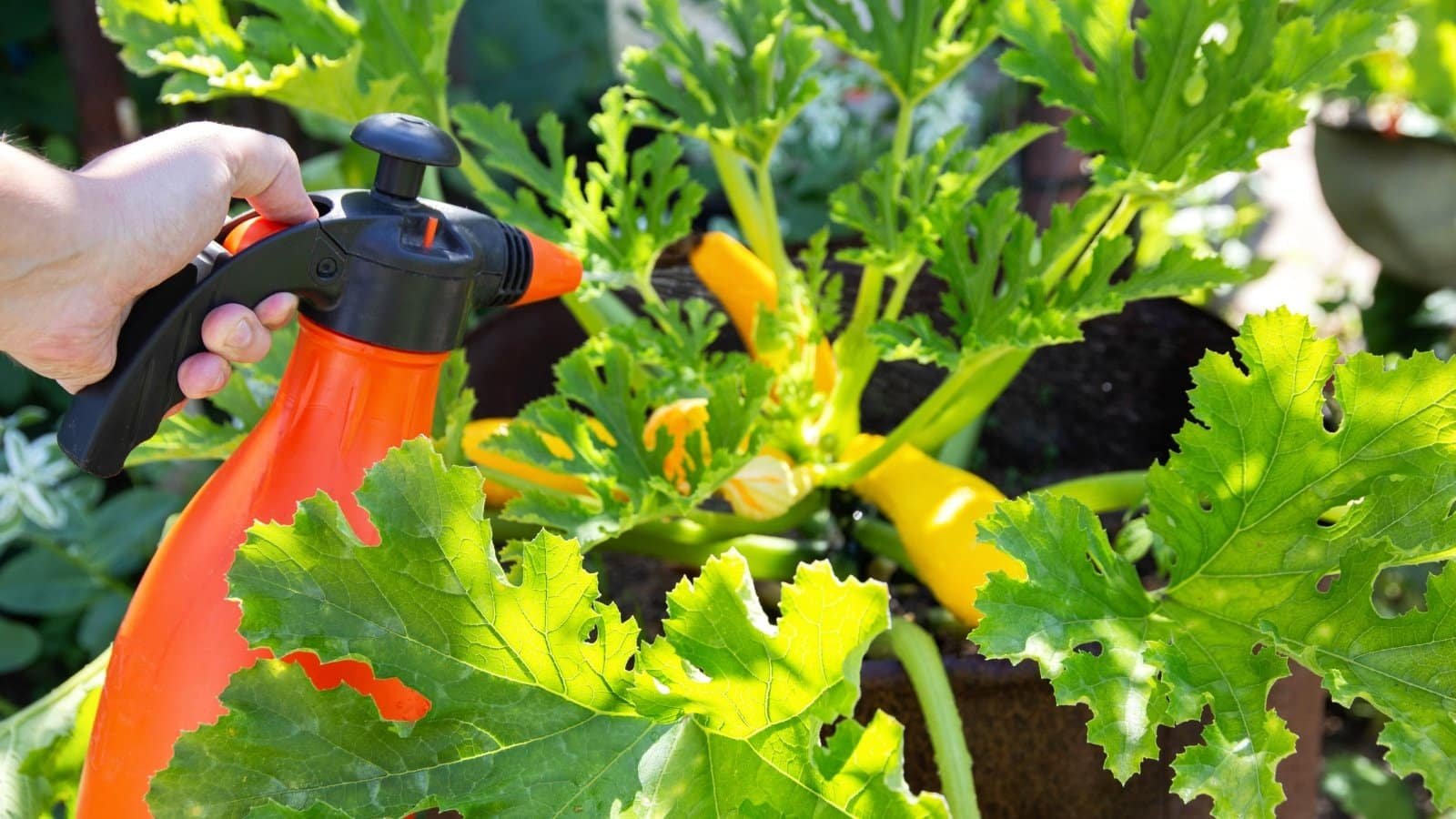Any time I’m outside, from spring through fall, I am on the lookout for interesting critters. A flutter of wings catches my eye, and I stop to admire a colorful butterfly. If I’m walking along a busy street or on the edge of a golf course, the butterfly doesn’t stop; it just keeps flying, looking for food.
If you’re in a place surrounded by native plants and colorful flowers, I will likely see many different species. They don’t fly away; they flutter busily from one flower to the next, stopping to sip nectar or sun themselves on a tall blade of native grass. When there’s a moist patch on the ground, there are always numerous fluttery beauties puddling, sipping moisture, slowly opening and closing their spectacularly showy wings.
Do you want to create a butterfly haven in your yard? You’ll have to think like a butterfly and imagine what’s attractive from an insect’s point of view. They are drawn to the same basic necessities as all other animals: food, water, shelter, and a place to raise young. When you provide these basics in your garden, they will find it. The best part is that, what’s appealing to a butterfly, also looks great to humans.
Ready to improve your garden and make it a five-star butterfly habitat? Read on as we introduce 11 simple tips to help you attract more beautiful butterflies to your landscape.
Convert Grass to Flowers
Let’s say you have a lovely, uniformly green lawn. You’ve probably spent a lot of time, effort, and expense trying to keep it that way. If you’re hoping to attract butterflies to your yard, however, you’ll need to say goodbye to turfgrass.
Butterflies are most attracted to large swaths of colorful native plants with nectar-rich flowers. They fly around each day, on the lookout for food for themselves and host plants on which to lay their eggs. Pollinators seek diversity, consistent sources of nectar, and shelter from a passing storm. These pretty insects won’t find any of that in a manicured lawn and simply fly past, looking for something better.
Fortunately, you don’t need to convert your entire lawn into a prairie garden (although you certainly can if you want to!). You can start small and build your butterfly garden in manageable increments. A single flowering plant may attract a passing butterfly, while a pollinator-friendly landscape will encourage a diverse and lively assortment to feel right at home.
Grow Native Plants
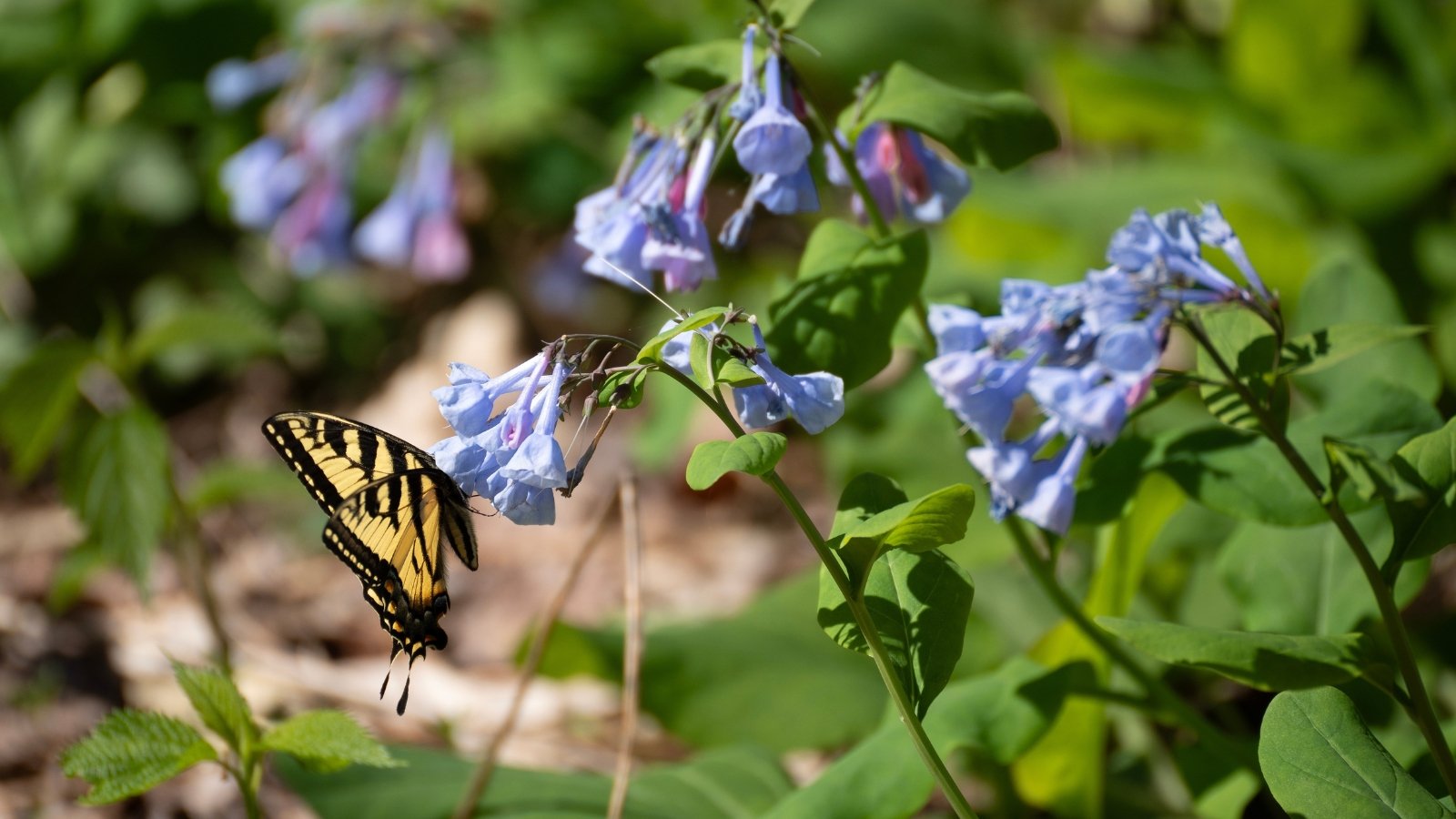
The species that live in your region have co-existed with the regional native plants for as long as they have existed. These plants and animals evolved together, and each species benefits the other. Native plants and butterflies are both essential parts of a healthy and balanced natural ecosystem. These species are valuable resource for all pollinators, birds, wildlife, and the environment.
Many butterfly species depend on native plants for their survival. Native plants provide a source of food for both adults and their caterpillar larvae. Butterflies have specialized needs and native plants can provide for all of their needs. Fortunately, native plants are also beautiful and easy to grow, allowing gardeners plenty of spectacular options for any environment.
Here are just a few of the many interesting and diverse native plants that adults adore:
| Species | Plant Type | Bloom Time |
| Aster Symphyotrichum spp. | Herbaceous perennial | Summer, Fall |
| Bee Balm Monarda spp. | Herbaceous perennial | Summer |
| Blazing Star Liatris spp. | Herbaceous perennial | Summer, Fall |
| Buttonbush Cephalanthus occidentalis | Shrub | Spring, Summer |
| Eastern Redbud Cercis canadensis | Small tree | Spring |
| Golden Currant Ribes aureum | Shrub | Spring, Summer |
| Goldenrod Solidago spp. | Herbaceous perennial | Fall |
| Ironweed Veronia spp. | Herbaceous perennial | Summer |
| Purple Coneflower Echinacea purpurea | Herbaceous perennial | Spring, Summer, Fall |
| Rattlesnake Master Eryngium yuccifolium | Herbaceous perennial | Summer |
Welcome Caterpillars
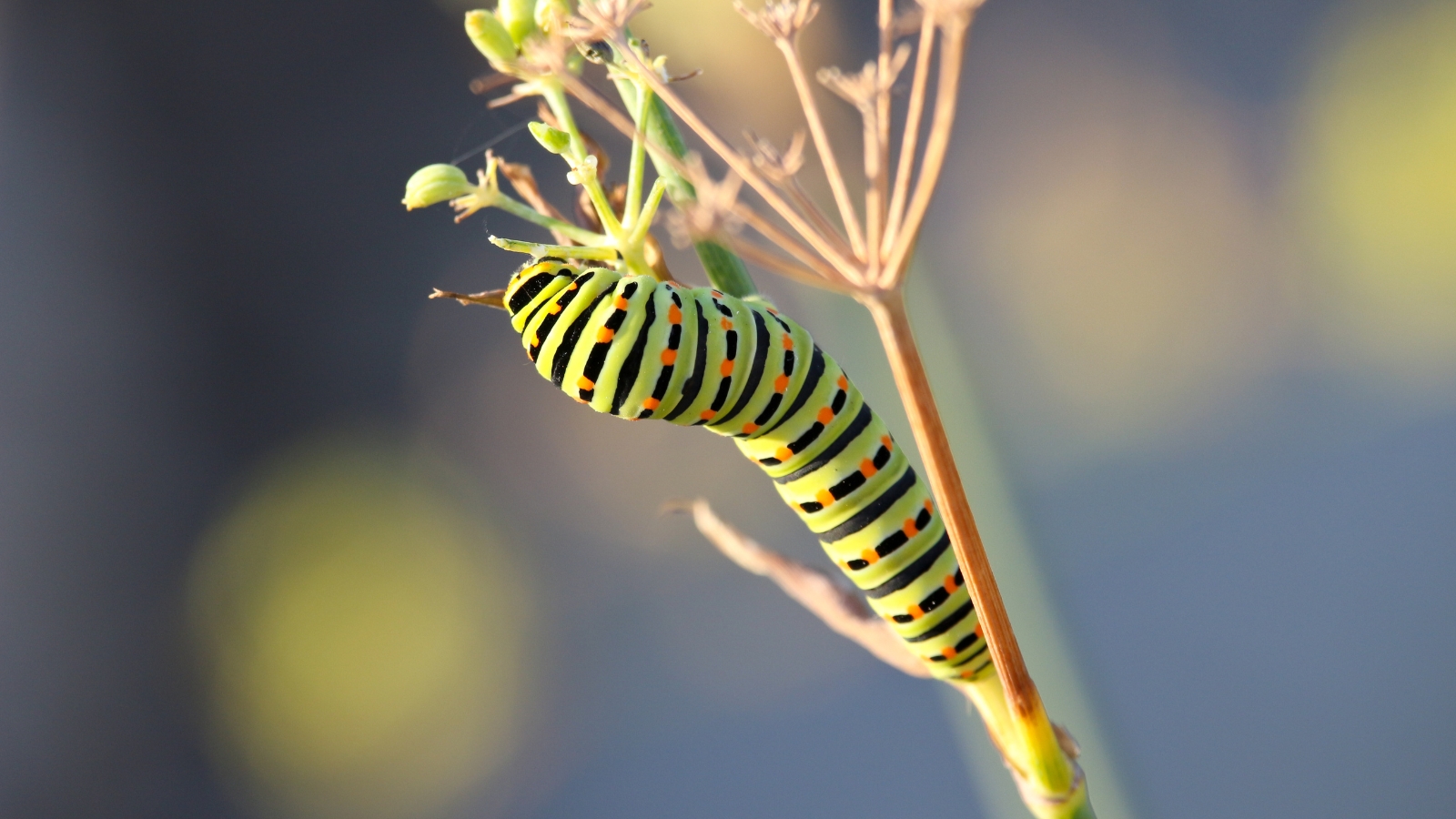
Remember that every single butterfly you see started its life as a caterpillar. Caterpillars are fascinating creatures. Each species has specially adapted to require specific host plants to feed its caterpillars. The monarch butterfly caterpillar, for example, only eats milkweed. Therefore, in order to support the next generation of monarchs, we need to provide a steady supply of milkweed plants throughout the monarch’s range.
When you’re gardening for butterflies, always try to include an assortment of plants to serve as larval host plants. By doing this, you not only welcome the adult butterflies to your garden, but you also expect some of your plants to get eaten by caterpillars. Knowing that those hungry caterpillars will soon turn into beautiful fluttering insects, you’ll be able to appreciate these amazing creatures feasting on your garden and adding their own unique looks to your landscape.
These are excellent species for attracting caterpillars:
| Species | Plant Type | Host Plant For |
| Parsley Petroselinum crispum | Biennial herb | Black Swallowtail |
| Fennel Foeniculum vulgate | Perennial herb | Black Swallowtail |
| Rose Mallow Hibiscus moscheutos | Shrubby perennial | Gray Hairstreak, Painted Lady, Checkered Skipper |
| Purple Passion Flower Passiflora incarnata | Vine | Gulf Fritillary, Variegated Fritillary, Zebra Heliconian |
| Milkweed Asclepias spp. | Herbaceous perennial | Monarch |
| Bird’s Foot Violet Viola pedata | Herbaceous perennial | Fritillary |
| Everlasting Anaphalis margaritacea | Herbaceous perennial | American Lady |
| Snapdragon Antirrhinum majus | AnnualShort-lived perennial | Buckeye |
| Wooly Pipevine Aristolochia tomentosa | Vine | Pipevine Swallowtail |
| Blueberry Vaccinium spp. | Shrub | Brown Elfin, Henry’s Elfin, Spring Azure |
Don’t Use Pesticides
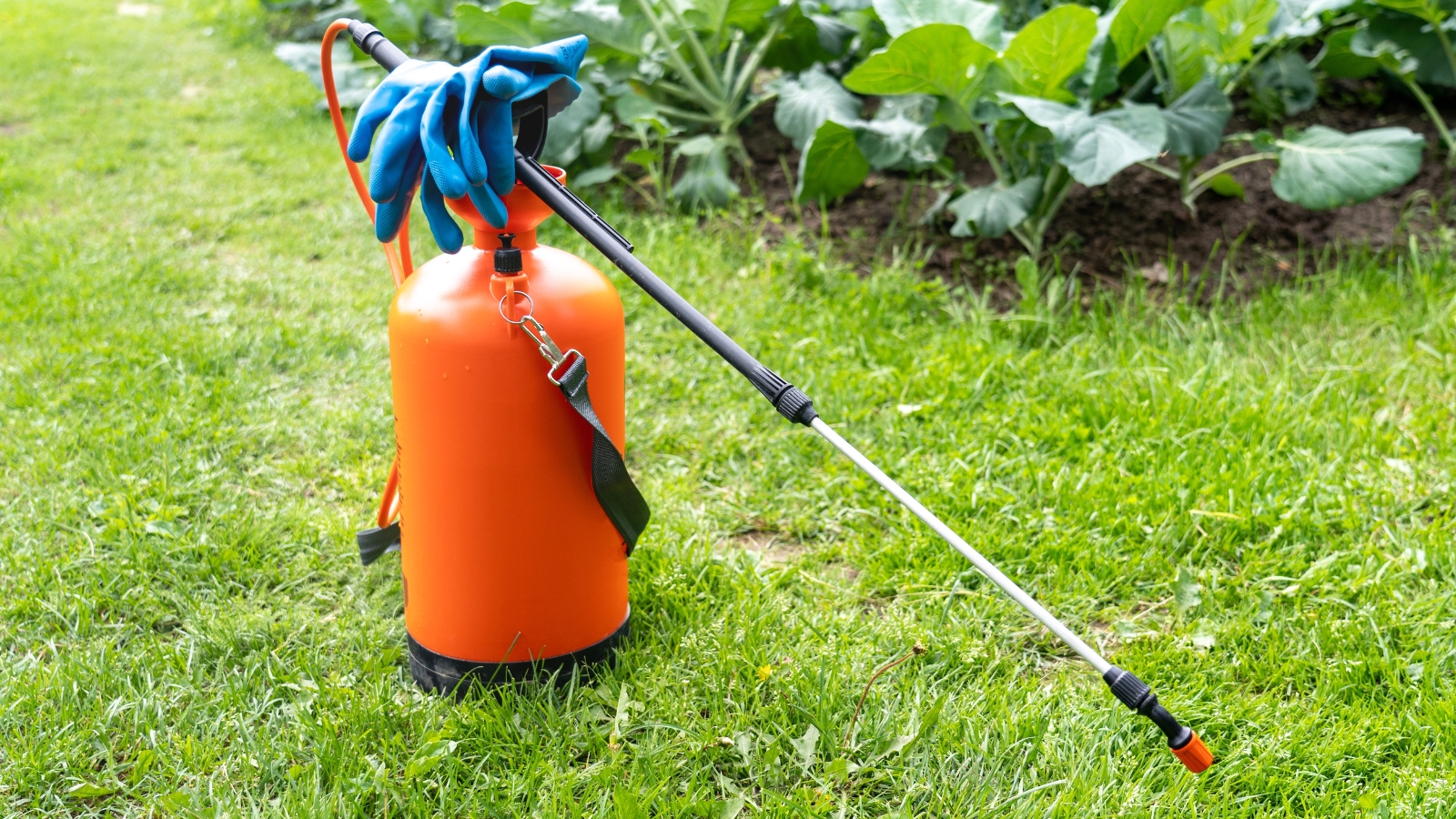
When you roll out the welcome mat to your local butterflies by planting an array of showy and nutritious plants, don’t then use pesticides in your landscape. Pesticides are indiscriminate and will kill all the insects in the area, including adults and caterpillars.
Fortunately, when you create a welcoming habitat that attracts butterflies, you are also creating an ideal habitat for many other beneficial insects. Your butterfly garden will be a haven for a wide assortment of pollinators, insect predators, hummingbirds, and other songbirds. When you have healthy populations of birds and beneficial insects, they will naturally prey upon your insect pests and provide a valuable environmental service to you!
Ensure Continuous Floral Color
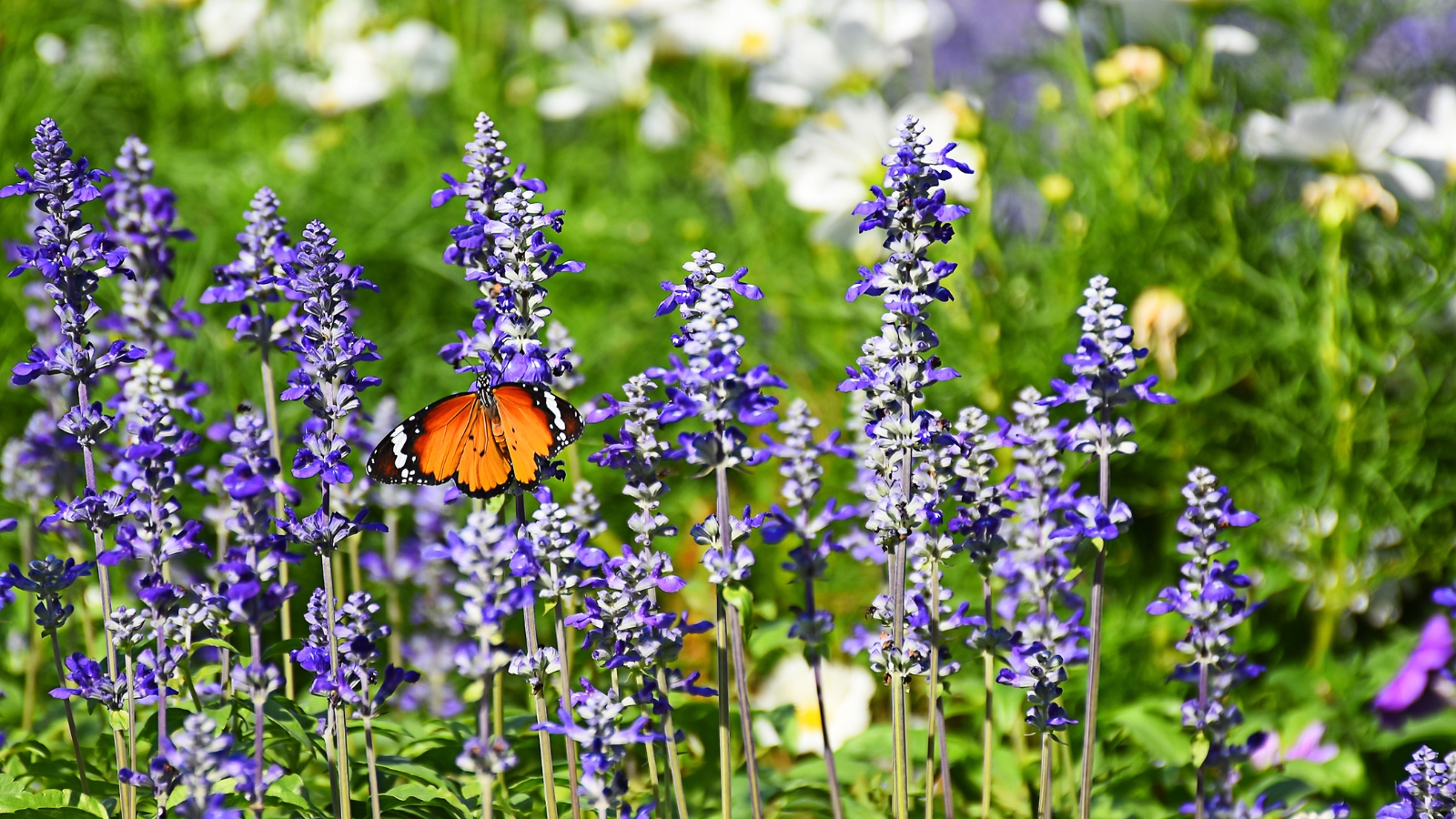
Anytime the weather warms above about 60°F (16°C), even on the occasional warm winter day, you may see insects flying. These adult butterflies are looking for nectar. They won’t find much until spring in most winter climates. Once the days get longer and the temperature warms, the first flowers will bloom, and pollinators will be out and about, looking for food.
Want to attract more butterflies to your yard? Offer them a smorgasbord of different flowers that bloom during the early days of spring, through the hot days of summer, and continuing throughout the fall, all the way until the first frost. They need a constant source of nectar, and you can help provide that by planting flowers that bloom in different seasons. Any time you don’t have nectar-rich flowers blooming, they will look elsewhere for their next meal.
Be sure to include some plants that flower early at various times throughout your growing season so you can attract butterflies during the spring, summer, and fall. Many of these plants have numerous and highly varied species to choose from, so you can decide which specific species or variety you want to try in your garden.
| Species | Plant Type | Bloom Time |
| Woodland Phlox Phlox divaricata | Herbaceous perennial | Spring |
| English Lilac Syringa vulgaris | Shrub | Spring |
| Chives Allium schoenoprasum | Perennial herb | Spring |
| Cosmos Cosmos bipinnatus | Annual | Summer |
| Blanket Flower Gaillardia spp. | Short-lived perennial | Summer |
| Zinnia Zinnia elegans | Annual | Summer, Fall |
| Lantana Lantana urticoides | Annual, Perennial | Summer, Fall |
| Salvia Salvia spp. | Herbaceous perennial | Summer, Fall |
| New England Aster Aster novae-anglae | Herbaceous perennial | Fall |
Plant Arrangement Makes a Difference
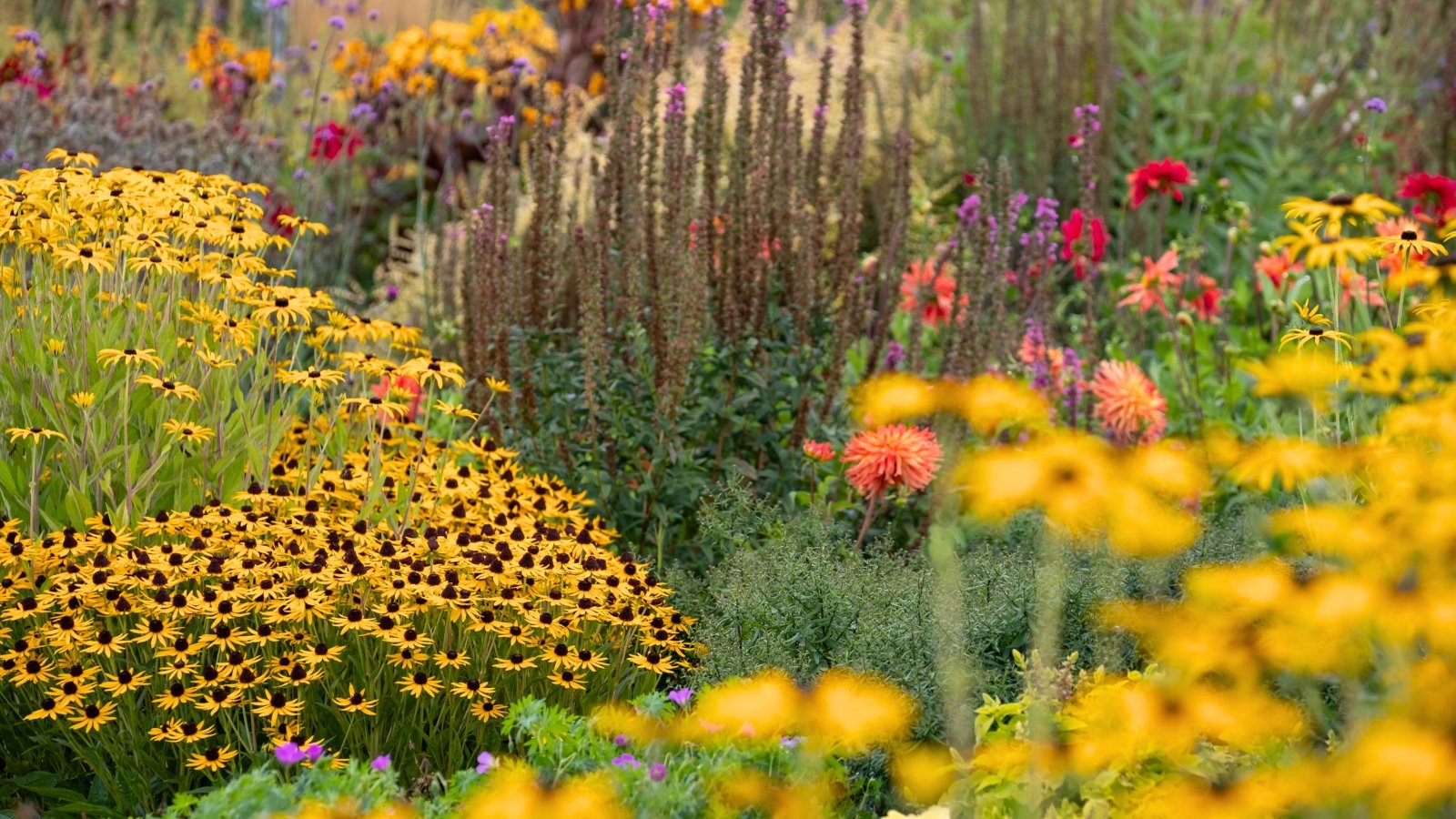
You can grow a flower in a pot and attract a butterfly or two. Do you want to make a bigger difference? Arrange your plants in colorful drifts. Drift planting is a fancy way to say that a few species are growing in larger masses or groups rather than growing singly as isolated individuals. You don’t want to fill your landscape with a single species of flower but rather grow a butterfly’s favorite flowers in groups.
Drift plantings not only attract the attention of butterflies and other pollinators, but they also look great and increase the curb appeal of your garden. A dramatic swatch of color is extremely eye-catching, and butterflies tune into these mass plantings. As a butterfly is flying overhead looking for its next meal, it is much more likely to stop for a concentrated and abundant nectar source than a few single flowers.
Offer Ideal Flower Types
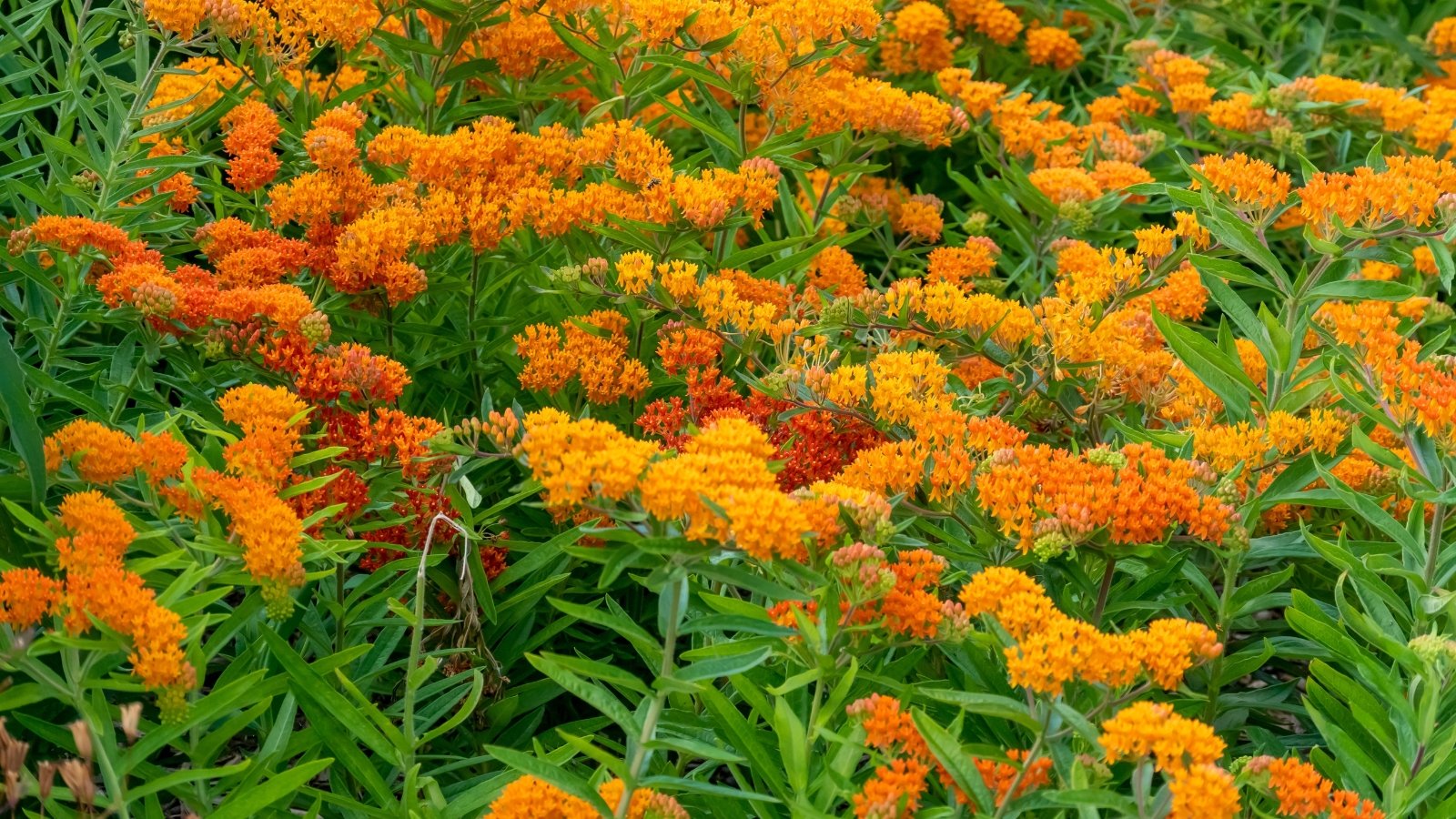
You may think that fancy, double-blooming flower is really pretty, but a butterfly can’t use it. Why? Double-bloom flowers are often so petal-heavy that the petals cover the center of the flower, blocking access to the nectar.
Research shows that there are a few flower characteristics that butterflies find especially attractive. They love flat-topped flowers and dense clusters of tiny flowers where they can land and walk around, sipping nectar from many little flowers together in one stop. Certain flower colors are particularly attractive to their eyes, especially red, orange, yellow, pink, and purple, although they will feed from any flower color, as long as it provides nectar.
Individual flower shapes also make a difference. Flowers with long, extended tubes may be inaccessible, but flowers with short tubes contain an abundant supply of nectar that butterflies can easily reach with their long, tongue-like proboscises. Again, butterflies will visit a variety of flower shapes as long as the nectar is accessible.
Fun Fact: Butterflies don’t eat, they drink. These fascinating insects have a long, thin, tubular tongue called a proboscis. When it isn’t drinking, a butterfly curls up its proboscis in a little loop under its chin. When it finds a flower to feed on, it uncurls its proboscis, pokes it into the nectar-rich center of a flower, and sips through it like a straw.
Include Trees and Shrubs
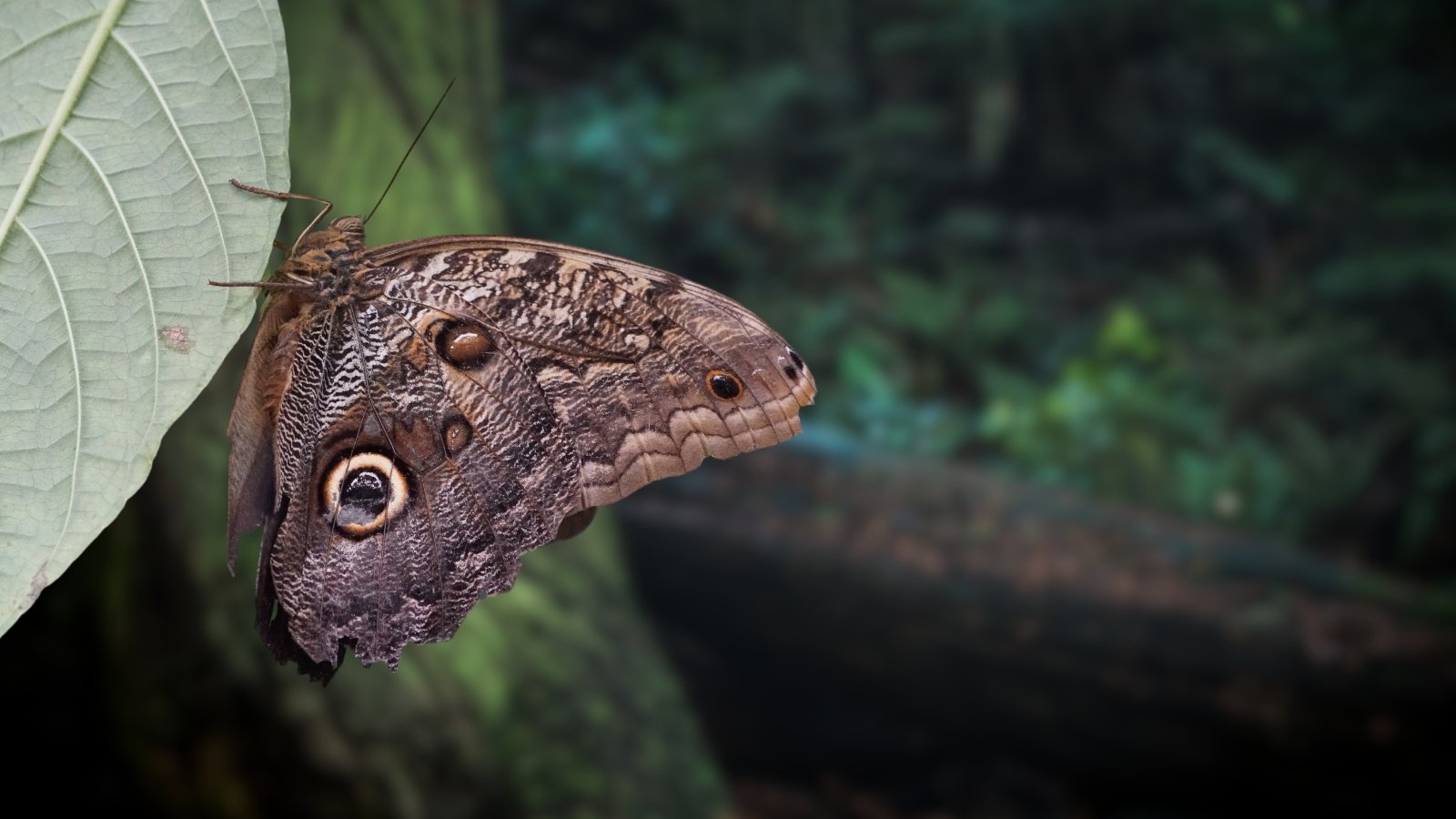
Flowers are the number one way to attract butterflies to your yard, but flowers only serve one function: a feeding station. They also need shelter from trees and shrubs.
Insects need places to rest, and when it gets dark at night, they look for a sheltered location to stay safe. Butterflies need protection from storms and bad weather. Trees offer excellent, stable protection from the elements. You may not even realize it because trees are so large but many butterflies use trees as host plants and sources of pollen. So go ahead and grow a native tree or shrub and you will also provide additional valuable habitat.
A sampling of native trees and shrubs that are also host plants or nectar sources include:
| Species | Nectar Season | Caterpillars Hosted |
| Pawpaw Asimina triloba | Spring | Zebra Swallowtail |
| Hackberry Celtis occidentalis | Spring | Question Mark, Hackberry Emperor, Tawny Emperor, American Snout, Mourning Cloak |
| Pagoda Dogwood Cornus alternifolia | Spring | American Snout, Spring Azure |
| Yellow Poplar Liriodendron tulipifera | Summer | Eastern Tiger Swallowtail, Spicebush Swallowtail, Viceroy |
| American Plum Prunus americana | Spring | Coral Hairstreak, Eastern Tiger Swallowtail, Spring Azure, Viceroy, Red-spotted Purple |
| Carolina Willow Salix caroliniana | Spring | Viceroy, Eastern Tiger Swallowtail, Mourning Cloak, Red-spotted Purple, Eastern Comma |
| Serviceberry Amelanchier arborea | Spring | Red-spotted Purple, Viceroy |
Create a Puddling Station
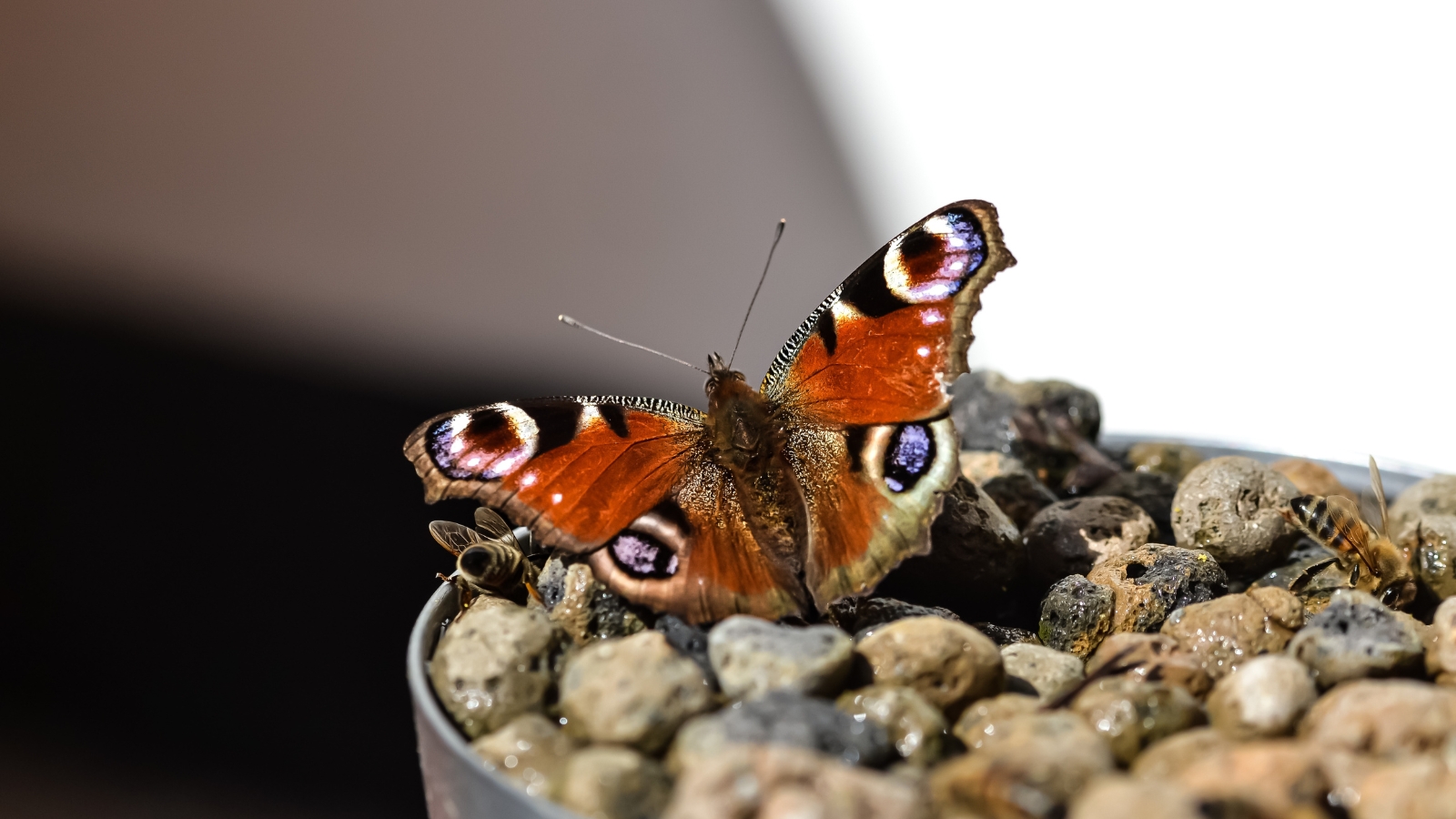
Butterflies are very attracted to little puddles of moisture. Create a simple puddling area to appeal to an assortment of species, including some that you may not typically see feeding on your flowers.
Use a shallow pan, tray, or dish to create your own simple puddling station. Fill it with a layer of coarse sand and a few pebbles. Add enough water to thoroughly moisten the sand without creating a puddle of standing water. The insects will land on the sand and pebbles, extend their long curled tongues, and lap up moisture and minerals from the wet sand. Puddling stations will dry out quickly on hot summer days, so add some fresh water every morning to keep the sand moist.
Offer Fruit
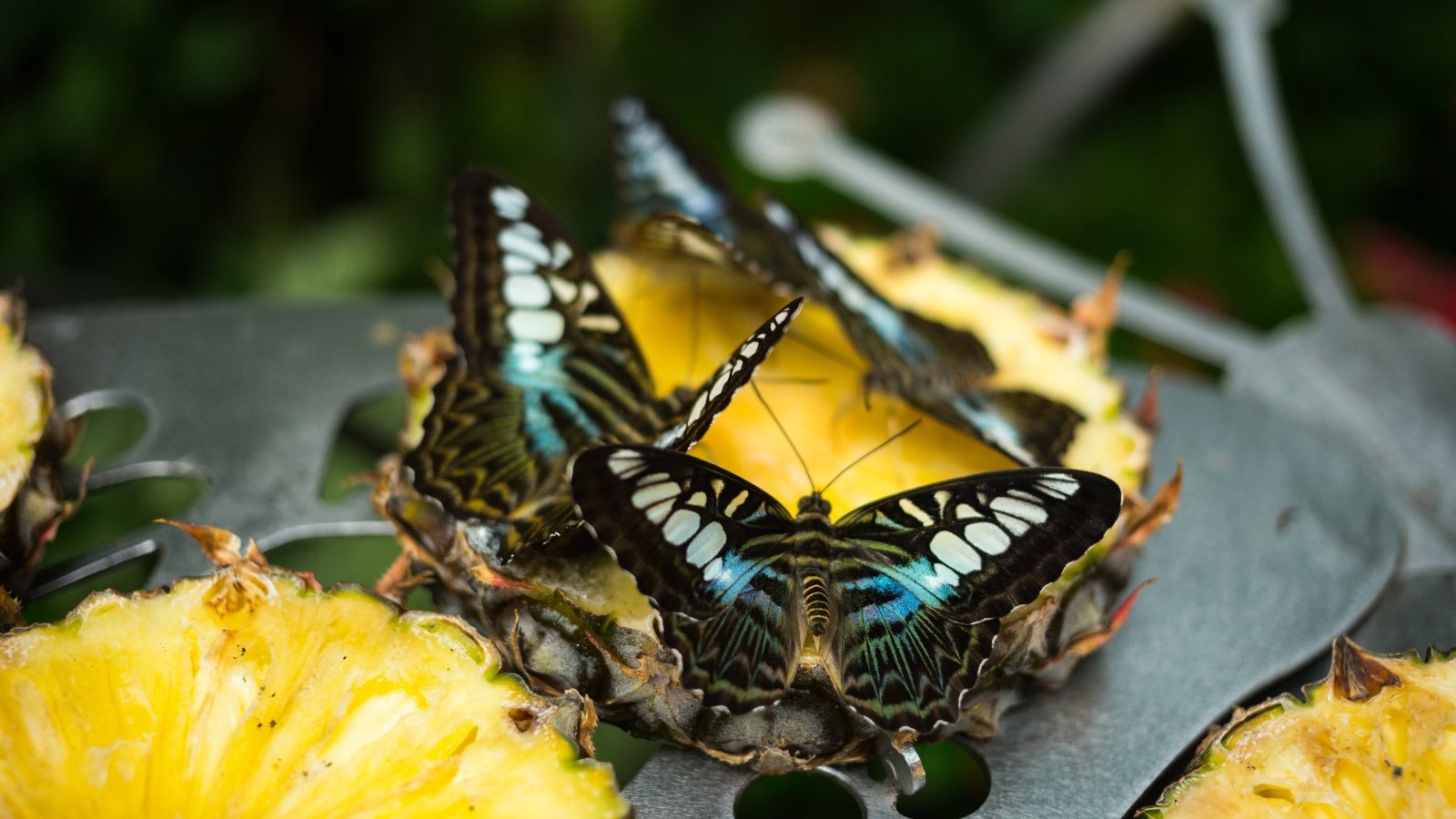
It may seem a bit unconventional, but a feeding station will attract some different species that you may not see on flowers. We think of butterflies as flower pollinators, although some are especially attracted to sweet, slightly overripe fruits.
Choose a shallow tray, such as a saucer from the bottom of a pot. Place it on a raised platform in a sunny spot in your yard. Add a few pieces of fruit, such as a few banana slices, orange slices, or a slice of pear, watermelon, or pineapple. Hungry butterflies will come by to investigate and sip the sweet juices from the fruits.
You’ll want to compost the fruit slices at the end of the day so they don’t rot completely and start to stink. Cleaning up the fruit station each evening will also deter nocturnal animals, such as raccoons and opossums, from making a mess of your pollinator feeding area.
Don’t Neglect Winter Habitat
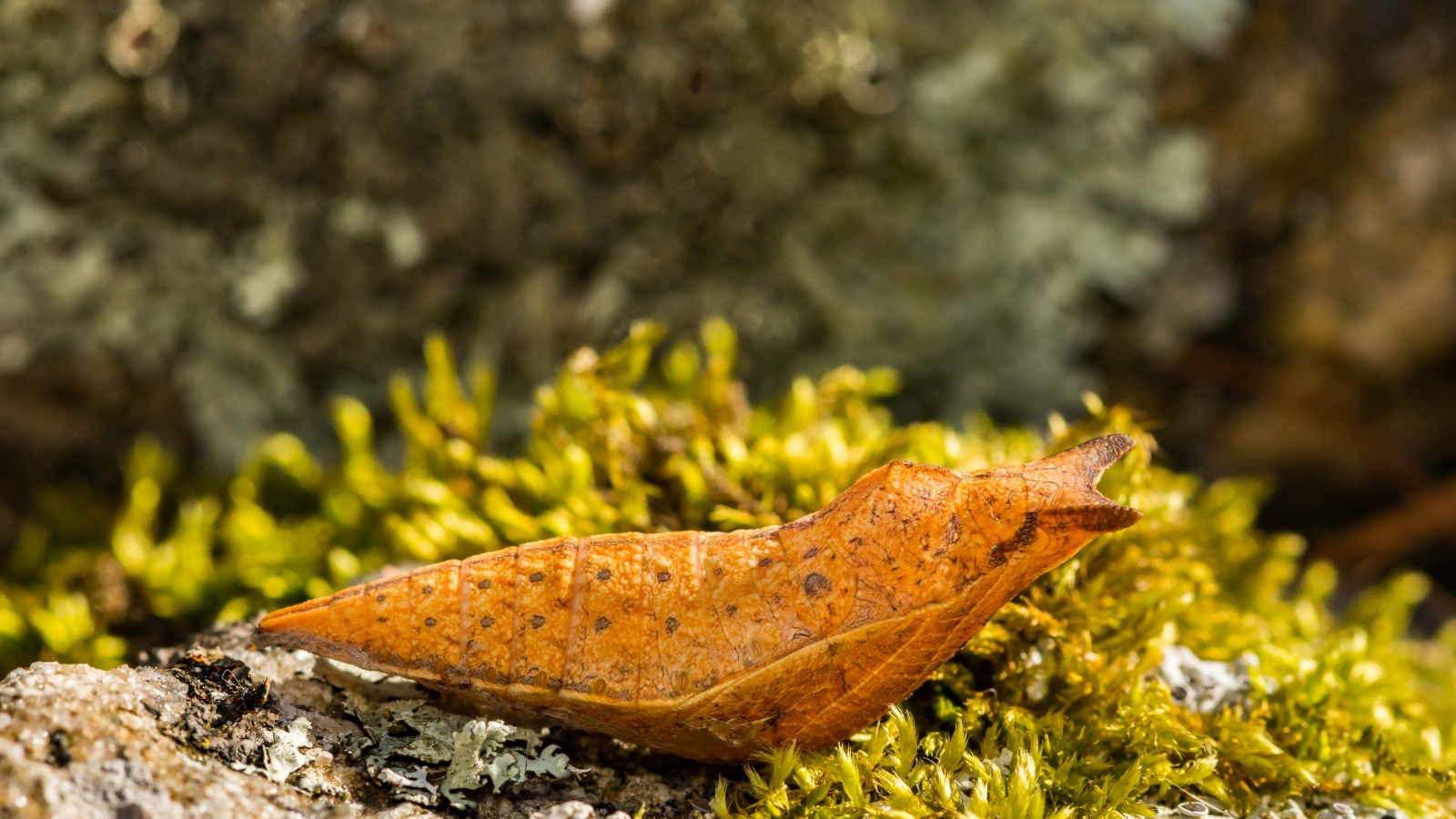
Where do butterflies go in the winter? We don’t see butterflies flying around during the cold winter months but they’re still around. Butterflies can overwinter at any point during their life cycle: egg, larvae, pupa, or winged adult, depending on the species. Many species overwinter as a pupa, quietly attached to a plant stem or hidden in a pile of brush. They wait until the warm spring weather allows the pupa to finish maturing and later emerge as a winged adult.
Chances are, however, that you won’t notice an overwintering butterfly. So what are some steps you can take to provide habitat for these hidden beauties?
- Leave your leaves. Lots of butterflies overwinter in fall leaves. Leave your leaves on the ground to provide cover and protection for any overwintering butterflies that made their homes there.
- Don’t immediately prune back your perennials. The more standing vegetation you leave over the winter, the more habitat you provide for overwintering butterflies. Leftover seeds also provide bonus food for foraging winter birds.
- Delay fall cleanup. You may be tempted to get your entire garden tidied up as soon as the first frost hits. If you can, wait until spring to clean up your yard. You have already worked hard to attract butterflies to lay their eggs and feed their young. Now you can help these beautiful creatures crawl, flutter, and pollinate into the next season.
It’s easy to attract butterflies to your yard. It doesn’t require much extra effort, but you must keep the entire life cycle in mind. Try one or more of these methods to enhance the beauty and diversity of your garden:
- Grow caterpillar host plants to attract adults that will lay their eggs. These host plants then feed the hungry caterpillars which turn into the next generation of butterflies.
- Choose easily accessible, nectar-rich flowers to feed adults. Any flower that attracts adults will probably attract many other beneficial insects as well!
- Butterflies are active from spring through fall. Make sure you provide plenty of flowering plants that bloom during each of these seasons.
- Offer shelter such as trees and shrubs, and safe places for overwintering insects, such as leaf piles and brush piles.
- Prioritize native plants. Native plants offer the greatest value for your pollinator-friendly garden. They’re easy to grow, low-maintenance, and perfectly well-adapted to support our favorite winged beauties.
- Offer a gentle water source because these delicate creatures still need to drink water.
- Get creative and let your garden be a little wild. A “perfect” garden isn’t necessarily the best. These insects are more drawn to natural-looking landscapes with lots of variety.
- When you create a welcoming environment for butterflies, you also help other pollinators, beneficial insects, birds, and other wildlife.



